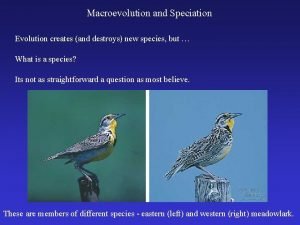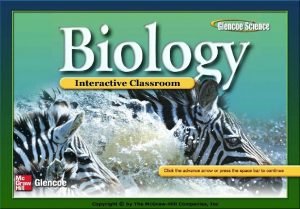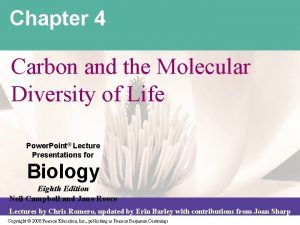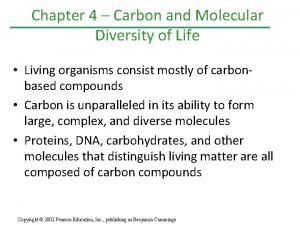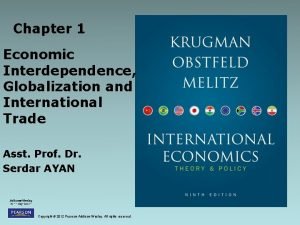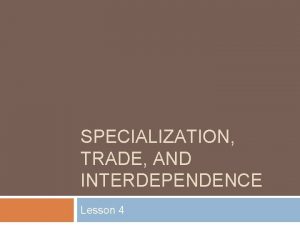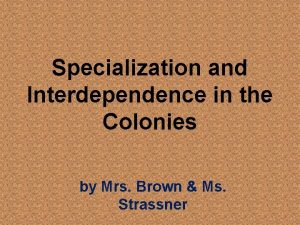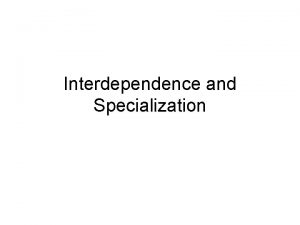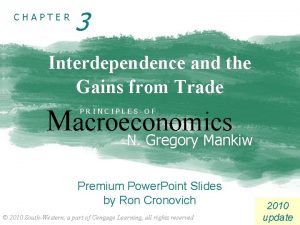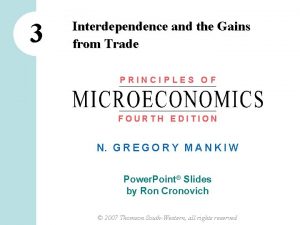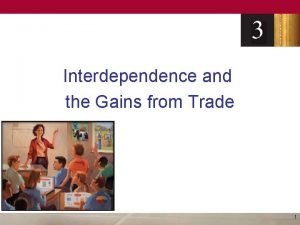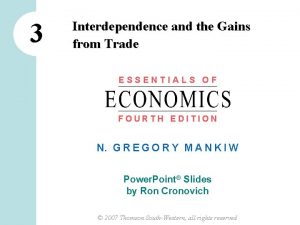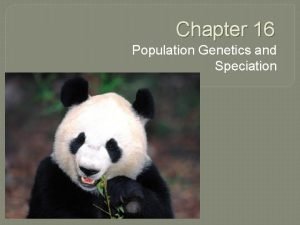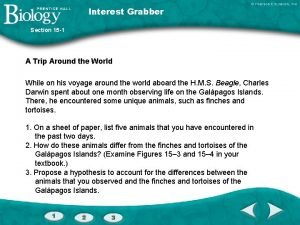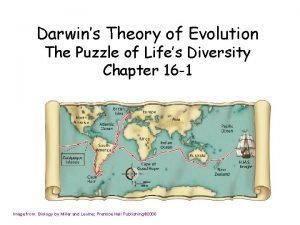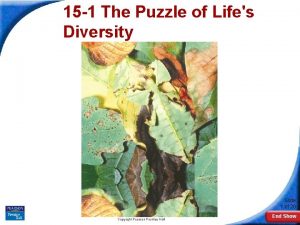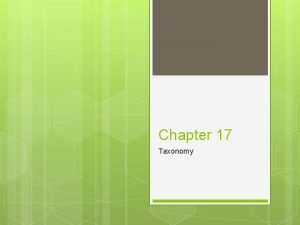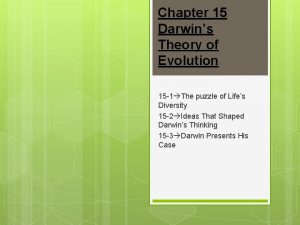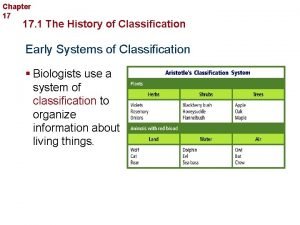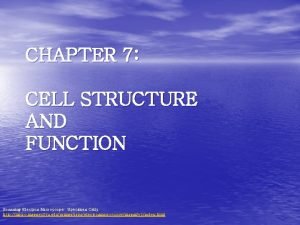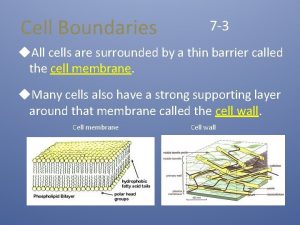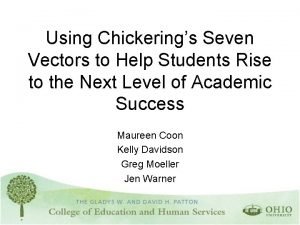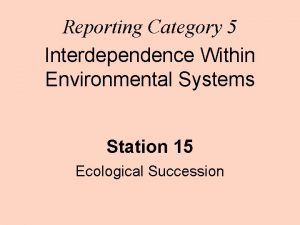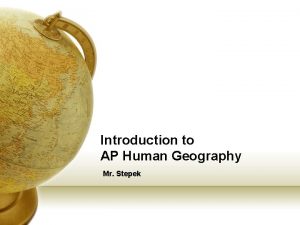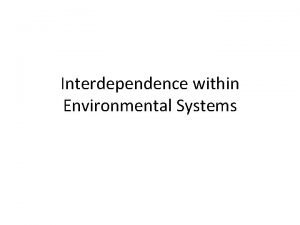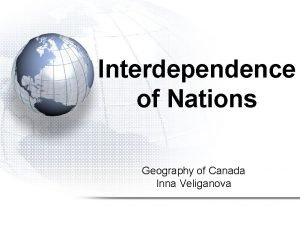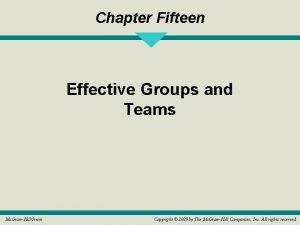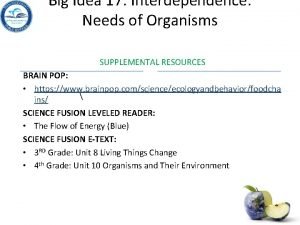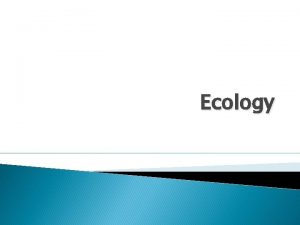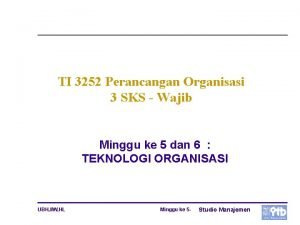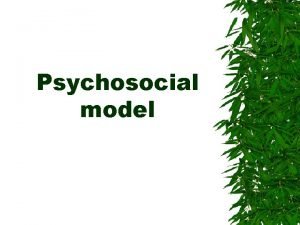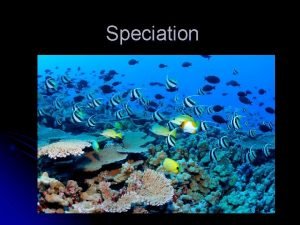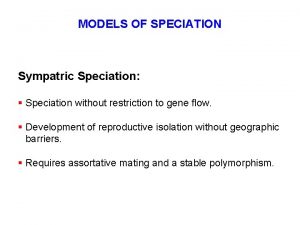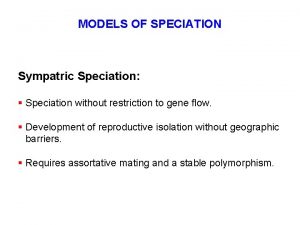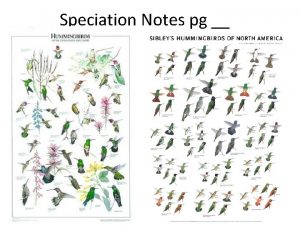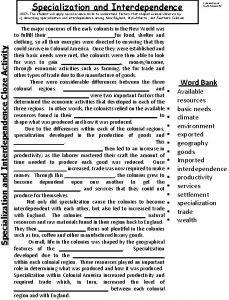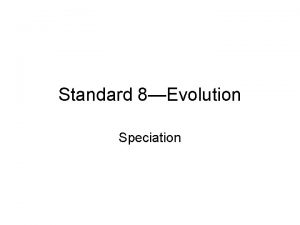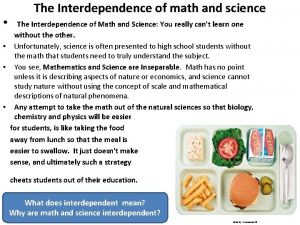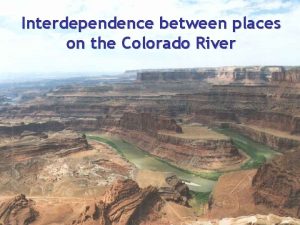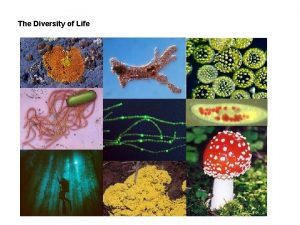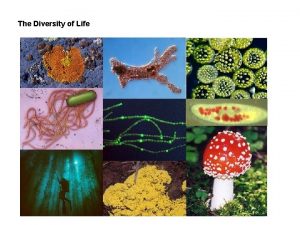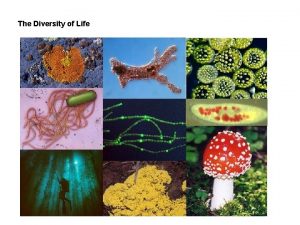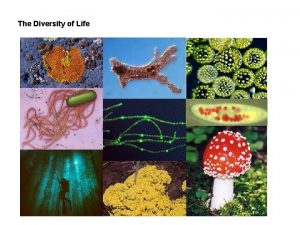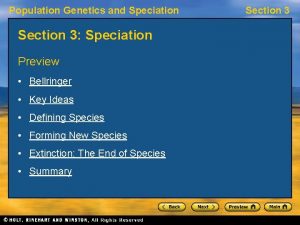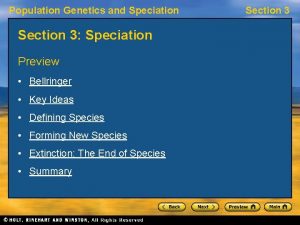Diversity and Interdependence of Life Speciation Speciation is













































- Slides: 45

Diversity and Interdependence of Life

Speciation • Speciation is the formation of a new species. • What determines if different organisms are different species? – A species consists of all individuals that can breed together and produce fertile offspring. • This definition is called the Biological Species Concept. • Two criticisms of this definition are: • Doesn’t work for asexual reproduction • Can’t determine if newly identified fossils are a new species.

A female donkey mated to a male horse produces what?

A mule, which is sterile. Hence, donkeys and horses are separate species.

What causes speciation? • Speciation occurs when a group separates from other members of its species (gene flow can’t happen between them) and then evolution mechanisms work on the separate populations. • What causes a group to separate from other members of its species? • Allopatric speciation (Geographic isolation)- A physical barrier, such as a mountain range or a waterway, makes it impossible for members of a species to breed with one another.

What causes a group to separate from other members of its species cont…? • Sympatric speciation- Members of a species are not geographically isolated but are isolated in another way, which prevents them from mating and sharing genes. • Temporal isolation- Members of a population have different mating seasons. • Behavioral isolation- Members of a population have different mating rituals. • Habitat isolation- Members of a population prefer different habitats.

How are different species named? • Taxonomy- The science of naming and classifying organisms. • A Swedish biologist named Carolus Linnaus came up with a two-word system for naming organisms. It is called binomial nomenclature. • There are 7 levels of classification: Kingdom-Phylum-Class-Order-Family-Genus-Species • In binomial nomenclature, the first word is the organism’s genus name and the second word is the species name.

Human Classification Kingdom: Animalia Phylum: Chordata Class: Mammalia Order: Primate Family: Hominidae Genus: Homo Species: Sapien (means “wise”) • Using binomial nomenclature, we are Homo sapiens. Always capitalize the genus and italicize or underline both the genus and species names.

The levels get more specific as you work down to the species.

Have all living things been classified? • NO! Our knowledge of all living things is limited. • Classification is based on anatomy, embryology, DNA, behavior, and when the organism evolved. • If you are unsure of the binomial nomenclature of an organism, you can use an identification system called a dichotomous key.

Example of a Dichotomous Key

Quick Review • How can we determine if similar organisms belong to a different species? • What are the 7 levels of classification? • How can you learn the classification of an organism if you don’t know it?

Interdependence of Life • Ecology- The study of relationships between living things and their environment. • Biosphere- The area around the earth where life exists. – includes the hydrosphere, lithosphere, and atmosphere

Levels of the Biosphere • Biome- a large area characterized by certain animal and plant species as well as climate • Ecosystem- All of the living and non-living components of a particular geographic area. • Community- A naturally occurring group of plants and animals living in a particular area. • Population- A group of organisms of one type (species) living in a particular area. • Habitat- The physical area in which an organism lives. • Climate- The prevailing weather conditions of a geographic area.

Levels of a Biosphere BIOSPHERE BIOME ECOSYSTEM COMMUNITY NON-LIVING COMPONENT (Habitat and Climate) POPULATION

Components of an Ecosystem • Abiotic- Non-living Components – – – – Sunlight Temperature Soil chemistry Precipitation Air Viruses- Can’t reproduce on their own, aren’t cells and don’t metabolize • Biotic – Living Components – – – Plants Animals Fungus Bacteria Protists Where do viruses belong?


Trophic Levels of Ecosystems A trophic level is a “feeding level”. – The relationship between what an organism eats and what eats it. – Where it fits into a food chain/web – The 1 st Trophic Level is at the bottom of the food chain.

How Biotic Factors Obtain Energy Producer (Autotroph) • Organisms that can make their own food = organic (carbon containing) materials • At the 1 st Trophic Level • Examples: plants and some bacteria • Photosynthetic- Use energy from sunlight and convert it into organic energy • Chemosynthetic- Use energy from inorganic compounds and convert it into organic energy

Consumer (Heterotroph) Organisms that cannot make their own food and must get it from an external source. • Primary (1 st) consumer- herbivore- eats only producers • Secondary (2 nd) consumer- carnivore- eats only consumers • Tertiary (3 rd), quaternary (4 th), etc. • Omnivore- eats producers and consumers • Detritivore- breaks down wastes and dead bodies by eating • Decomposer- fungi, bacteria: return nutrients to the soil for absorption through decomposition

Food Chain • Food Chain: Specific feeding sequence in which organisms obtain energy in an ecosystem Grass Caterpillar Sparrow Snake Coyote Arrows always point in the direction of energy flow! • Food Web: Interrelated food chains


FOOD WEB : • What is/are the producer(s)? • What is a herbivore? • What is a primary consumer? • What is a secondary consumer? • What is a tertiary consumer? • What would be 3 consequences in the fish population died out?

How do we keep track of energy in ecosystems? • Ecological Pyramids- A diagram that shows the amounts of energy at each trophic level in a food chain or food web. (3 types) 1. Numbers Pyramid: counts the # of individuals (does not discriminate by size) – can be an inaccurate indicator of energy at that level Ex. Caterpillars outnumber the trees that they feed upon The shape of this pyramid could be inverted!

How do we keep track of energy in ecosystems? 2. Biomass Pyramid: measures amount of living tissue (dry weight) in grams 3. Energy Pyramid: measures amount of energy stored in tissues fats = 9 Cal/gram carbohydrates/proteins = 4 Cal/gram

Biomass Pyramid

Energy Pyramid

Numbers Pyramid

Energy Transfer • Amount of energy available to do work decreases as energy passes through a system • 10% transfer of energy (90% energy lost) from one level to the next. Most is lost to the air as heat. • How much energy would be transferred to each level of the following food chain? Grass Caterpillar Sparrow Snake Coyote 1200 kcal

Biomagnification • Increase in the concentration of toxins up a food chain. • Chemicals and toxins accumulate more and more as you move up a food chain because they do not get broken down in the body. • High level consumers have to eat lots of organisms in the trophic level below to get enough energy (because so much is lost). Unfortunately, the toxins don’t get lost!


Population Size • Studying changes in population size is called population ecology. • This helps scientists predict future changes in populations and better understand how to conserve biodiversity. • Counting members of a population is often impossible. Estimation of population size can calculated using the Capture-Recapture Method.

Capture-Recapture Method • In the Capture-Recapture Method, a sample of animals are caught and tagged. They are then released back into their habitat. Other samples are then captured at various times and each time the total number and marked number of animals are noted. • The following equation is then used to estimate population size. Estimated Population Size = N x AC ACm N = number initially marked AC = average total number captured ACm = average total number captured with a mark

50 fish were captured, marked and put back into a pond. On 10 different occasions, samples were taken from the pond. What is the estimated population size? # total captured # marked in the sample 32 2 26 4 24 0 22 2 29 1 40 1 52 3 25 4 37 2 20 2

What is the estimated population size of geese?

Random Sampling • If members of a population are immobile, random sampling could be used to estimate population size. • A random sample is meant to be an unbiased representation of the total population. – Example: The chart below represents a 500 acre soybean plot that has been divided into 25 subplots. The number of soybean plants in 5 subplots have been counted. Estimate the total soybean population size.

122 70 148 102

How do populations grow? • Most populations grow either exponentially or logistically. • Exponential growth occurs when resources are plentiful and the reproduction rate is greater than the death rate. • On a graph, exponential growth looks like a “J”.

How do populations grow? • Logistic growth occurs if there are limited resources and growth of the population begins to slow as competition for those resources increases. The growth of the population eventually slows to nearly zero as the population reaches the carrying capacity for the environment. • On a graph, logistic growth looks like a “S”.


What is the Carrying Capacity?

Factors that Limit Population Growth In nature, population size and growth are limited by many factors. Density-dependent limiting factors: Affect the growth of the population dependent on how dense it is. • Biotic factors • Competition- When a population has a high density, more individuals are trying to use the same resources • Predation- Higher density populations attract predators more than sparse populations. • Parasitism/disease- Disease is more likely to result in deaths when more individuals are living together in the same place.

Density-dependent Factors cont… • Gradually slow the growth rate • Eventually lead to logistic growth with a carrying capacity

Factors that Limit Population Growth Density-independent limiting factors: Affect the growth of the population independent of how dense it is. Their strength doesn’t depend on the size of the population. • Abiotic- Natural disasters, severe weather and pollution • Abruptly reduce population size

1. 2. 3. 4. 5. 6. What is/are the autotroph(s)? What trophic level(s) does the hawk hold? What type(s) of consumer is the hawk? What is the role of the mushrooms? If the shrubs are 500 kcal, how much will the weasel get? What organism is subjected to the greatest biomagnification of pesticides used on the grass?
 Diversity and interdependence of life
Diversity and interdependence of life Sympatric speciation vs allopatric speciation
Sympatric speciation vs allopatric speciation Genetic diversity vs species diversity
Genetic diversity vs species diversity Ecosystem jigsaw activity
Ecosystem jigsaw activity Organizing life's diversity section 3 domains and kingdoms
Organizing life's diversity section 3 domains and kingdoms Define biodiversity conservation
Define biodiversity conservation Carbon and the molecular diversity of life
Carbon and the molecular diversity of life Chapter 4 carbon and the molecular diversity of life
Chapter 4 carbon and the molecular diversity of life Interdependence and gains from trade
Interdependence and gains from trade Economic interdependence pros and cons
Economic interdependence pros and cons Advantage of specialization
Advantage of specialization Southern colonies specialization
Southern colonies specialization Primary, secondary, tertiary industries
Primary, secondary, tertiary industries Specialization and interdependence
Specialization and interdependence Chapter 3 interdependence and the gains from trade
Chapter 3 interdependence and the gains from trade Chapter 3 interdependence and the gains from trade answers
Chapter 3 interdependence and the gains from trade answers Interdependence and the gains from trade chapter 3
Interdependence and the gains from trade chapter 3 Chapter 3 interdependence and the gains from trade summary
Chapter 3 interdependence and the gains from trade summary Interdependence and the gains from trade
Interdependence and the gains from trade Chapter 3 interdependence and the gains from trade
Chapter 3 interdependence and the gains from trade Population genetics and speciation worksheet answer key
Population genetics and speciation worksheet answer key Section 15-1 the puzzle of life's diversity answers
Section 15-1 the puzzle of life's diversity answers Section 15-1 the puzzle of life's diversity answer key
Section 15-1 the puzzle of life's diversity answer key The puzzle of life's diversity
The puzzle of life's diversity Organizing life's diversity
Organizing life's diversity Section 15-1 the puzzle of life's diversity answer key
Section 15-1 the puzzle of life's diversity answer key Chapter 17 organizing life's diversity
Chapter 17 organizing life's diversity Section 7-4 the diversity of cellular life
Section 7-4 the diversity of cellular life Section 7-4 the diversity of cellular life
Section 7-4 the diversity of cellular life Chickering's vectors
Chickering's vectors Interdependence within environmental systems
Interdependence within environmental systems Category 5 interdependence within environmental systems
Category 5 interdependence within environmental systems Types of task interdependence
Types of task interdependence Types of task interdependence
Types of task interdependence Perceptual region
Perceptual region Interdependence within environmental systems
Interdependence within environmental systems Inna model
Inna model Employing interdependence
Employing interdependence Pooled interdependence
Pooled interdependence Types of task interdependence
Types of task interdependence Big idea 17 interdependence
Big idea 17 interdependence Chemoautotrophs
Chemoautotrophs Neoliberalism complex interdependence
Neoliberalism complex interdependence Contoh pooled interdependence
Contoh pooled interdependence Interdependence is a psychosocial concept
Interdependence is a psychosocial concept Interdependence
Interdependence

